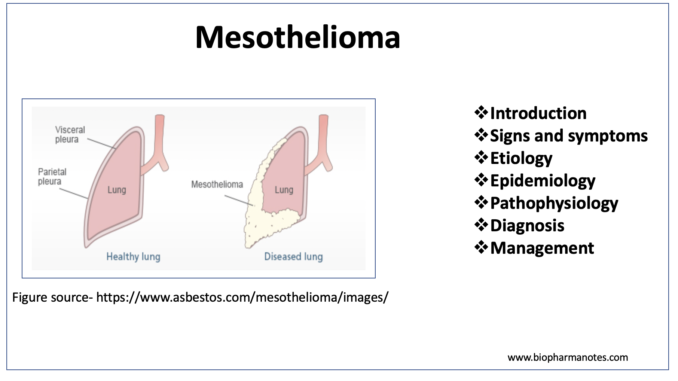
- Mesothelioma is the cancer of mesothelial cells. These cells form the lining layer of viscera like in pleura, peritoneum, and tunica vaginalis. The most common type is of pleural membrane which is also known as malignant pleural mesothelioma (MPM).
- It has insidious characteristic due to long latency period. It is rare and aggressive type of cancer.
Signs and symptoms of mesothelioma
- Its signs and symptoms are not very specific. Some symptoms include cough which is non-productive most of the times, chest pain and dyspnea. Dyspnea indicates presence of pleural effusion.
- There may be some other symptoms like weight loss, appetite loss, fatigue, wheezing and blood in sputum. Pleural plaques may also occur.
Etiology of mesothelioma
- Various research has suggested the strong association between asbestos and pleural mesothelioma. Around 10% of people with occupational exposure to asbestos develop it.
- There is no association between alcohol, smoking, tobacco, and dietary intake with mesothelioma. However, combined cigarette with asbestos exposure is found to increase risk of lung cancer by around 10-10 folds.
- Some other reports also associate it with ionizing radiation and simian virus SV-40. SV-40 nucleic acids are identified as cause of mesothelioma in cases without asbestos exposure.
Epidemiology of mesothelioma
- Its first case was reported in 1947. The cases were very rare during first half of 20th century and its cases has increased recently which can be linked with increased exposure to asbestos fiber. There are around 2000-2500 cases of mesothelioma in US every year.
- Compared to female, male are at increased risk due to occupational exposure. its incidence may be different in different countries. The reason for this difference is not known till date. Around 5% of individuals who are exposed to heavy asbestos for prolonged time may develop mesothelioma.
- Some of it’s cases are found in children which are not related to asbestos exposure.
Pathophysiology
- It can be of three types: epithelioid, sarcomatoid and biphasic. Biphasic type has characters of both epithelioid and sarcomatoid type. Tumor is multifocal and multiple nodules are formed.
- A series of pathological events may occur during long latency period of mesothelioma. Inhalation of asbestos fibers cannot be digested by macrophages and these fibers lead to production of ROS (Reactive Oxygen Species).
- Asbestos exposed mesothelial cells and macrophages induce inflammation and tumor development by producing different growth factors and cytokines including tumor necrosis factor a (TNF-a), platelet derived growth factor (PDGF), insulin derived growth factor-1 (IDGF-1) and transforming growth factor- b.
- Mesothelial cells may engulf asbestos fiber and the fibers may disrupt mitotic spindle and disturb cell cycle. as a result, aberration in chromosomal structure and aneuploidy of mesothelial cells may occur.
Diagnosis
- Diagnosis of mesothelioma may be quite hard as the symptoms are not specific. Adequate tissue is required for proper diagnosis. Some diagnostic procedures used are video assisted thorascopy, pleural fluid cytology obtained through thoracentesis, open thoracotomy. Biopsy may be useful in confirmation.
- Immunohistochemical staining may be helpful in differentiating mesothelioma from adenocarcinoma of lung origin.
Management
- After mesothelioma is confirmed, detailed staging work is done to determine the stage and standard management. Various other factors like comorbidities, pulmonary function and cardiac condition are also considered beside clinical stage.
- For patients who are in clinical stage 1st and are medically fit, surgery is recommended. Surgery is not recommended for patients in clinical stage IV, with comorbidity or with impaired health condition. The use of surgery is controversial due to limited evidence. Chemotherapy is recommended in such patients. For patients in stage II and III, trimodality therapy including surgery, chemotherapy and radiotherapy is recommended.
- Medicinal agents used in chemotherapy are gemcitabine, vinorelbine, cisplatin etc. Radiotherapy doesn’t increase survival but may help in reducing pain and reducing masses of chest wall.
References
- Mott FE et al. Mesothelioma: A Review. The Ocshner Journal. 2012 Spring; 12(1): 70–79.
- https://www.statpearls.com/ArticleLibrary/viewarticle/25030
- https://en.wikipedia.org/wiki/Mesothelium
- https://www.news-medical.net/health/Mesothelioma-Pathophysiology.aspx
- Asciak R et al. Update on biology and management of mesothelioma. Eur Respir Rev 2021; 30: 200226.
- Yang H et al. Mesothelioma Epidemiology, Carcinogenesis and Pathogenesis. Curr Treat Options Oncol. 2008 Jun; 9(2-3): 147–157.
- Asciak R et al. Update on biology and management of mesothelioma. Eur Respir Rev 2021; 30: 200226.